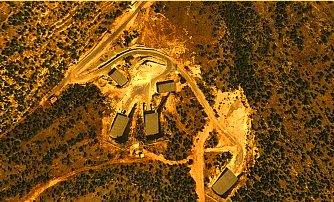Publications
INSS Insight No. 666, February 23, 2015

Syria has a long history of deception and lying to the international community on matters concerning its development and use of weapons of mass destruction (WMD). Therefore, any new information concerning these matters, even if highly speculative, should set the scene for further investigations, which in the past have revealed problematic Syrian intentions and activities in the chemical and nuclear realms.
On January 9, 2015, the German weekly Der Spiegel published an article entitled “Assad's Secret: Evidence Points to Syrian Push for Nuclear Weapons,” based on known facts, facts leaked to the journal, assessments, and speculations. According to the article, Syria did not give up its nuclear weapons development ambitions following the destruction of its almost completed, North Korean-constructed nuclear reactor near the town of Deir-al-Zor, on the banks of the Euphrates River. Instead, according to Der Spiegel, it is in the process of erecting a new nuclear facility near the town of Qusayr, very close to Syria’s border with Lebanon. The newspaper refers only to intelligence information from unnamed sources signifying that the facility is related to nuclear activities, without further assessment as to the nature of this facility, i.e., whether it is a nuclear reactor and/or a uranium enrichment facility. Both types of facilities can produce fissile materials – the materials from which nuclear weapons are produced. The article was received with much skepticism by the professional community, with some expressing their doubts as to the veracity of the information and others literally tearing the case apart, to the point of denouncing it as a hoax.
The satellite photography shown in the article does not present any indication as to the nature of the facility. It could well house a relatively small underground nuclear reactor that would be cooled by significant amounts of air that enter through a filtering system and exit through an exhaust stack (which is not visible in the photos) or concealed ventilation shafts. Were it to be cooled by water, it would need a significant water pipes system and a “heat sink” to remove the energy produced by the reactor. In the case of a reactor it would need the supplementary reprocessing and waste disposal facilities, in order to produce the plutonium needed for the production of nuclear weapons. Another option is that the facility houses a uranium enrichment facility, which does not produce energy and does not consume much energy, and thus does not need an extensive energy removal (cooling) system; alternatively, the necessary air-conditioning equipment and heat removal could be concealed from sight. It could also house auxiliary systems such as uranium conversion and storage facilities.
On a related point, the article notes that following the destruction of the Deir-al-Zor reactor, the equipment and materiel that survived the 2007 attack were removed from that site, and some of it could be used in the construction of the new facility. The Iranian Revolutionary Guards are also mentioned as involved in the Qusayr activities, as well as through the Iranian-led Hizbollah organization. But in any event, an analysis of the article confirms that the technical evidence is not sufficient to draw firm conclusions as to the nature of the activities at the Qusayr site. A review of any available past satellite photography and present-day heat photography could provide the necessary information, or at least some clues as to the nature of the site.
The article also highlights information about the continuation of Syrian-North Korean nuclear cooperation, although this comes from unnamed intelligence sources. The basis for concern regarding this bilateral relationship stems from the fact that the facility bombed in 2007 was a North Korean-style nuclear facility, and North Korean scientists were on the ground in Syria. It also raises again long-held concerns about the nature of probable trilateral cooperation in the WMD realm, among three states of concern: North Korea, Iran, and Syria. The Iranian link ties in both vis-à-vis North Korea and Syria. Bilateral cooperation between North Korea and Iran on ballistic missiles has been documented for years, and suspicions have been raised that it extends to the nuclear realm as well, with experts noting, for example, the presence of Iranian scientists at North Korean nuclear tests. Suspicions of the trilateral link focus mainly on the facility at Deir-al-Zor and the question of funding. North Korea assists would-be proliferators but only those that can pay hard cash; Iran could likely be the source of funds, in light of the very strong strategic relationship between the two states.
While the above concerns contain an element of speculation, relations between Syria and the international nonproliferation regime are a matter of documented fact. Syria has lied outright with regard to its chemical capabilities: in a 2005 report to the UN, regarding Resolution 1540, Syria stated as a matter of fact that it has no, and never had WMD, and has no intention of developing them in the future. Yet seven years later, in 2012, Assad was already issuing chemical weapons threats, and over the course of 2013 actually used them on the Syrian population. Following its use of chemical weapons in the summer of 2013, Syria was compelled to admit its chemical weapons activities and to join the Chemical Weapons Convention; it then dismantled facilities and gave up at least some of its arsenal that was destroyed outside its territory.
Syria has also been uncooperative in the nuclear realm. Following the 2007 attack, it has stonewalled repeated requests from the IAEA to inspect the Deir-al-Zor site after the one and only inspection in June 2008. Similarly, the International Atomic Energy Agency (IAEA) is almost powerless to act in a legal way to ascertain the nature of the facility at Qusayr; its only option is to request a “special inspection” at that site. However, such a request will probably be refused by Syria, in the same manner as a North Korean refusal.


